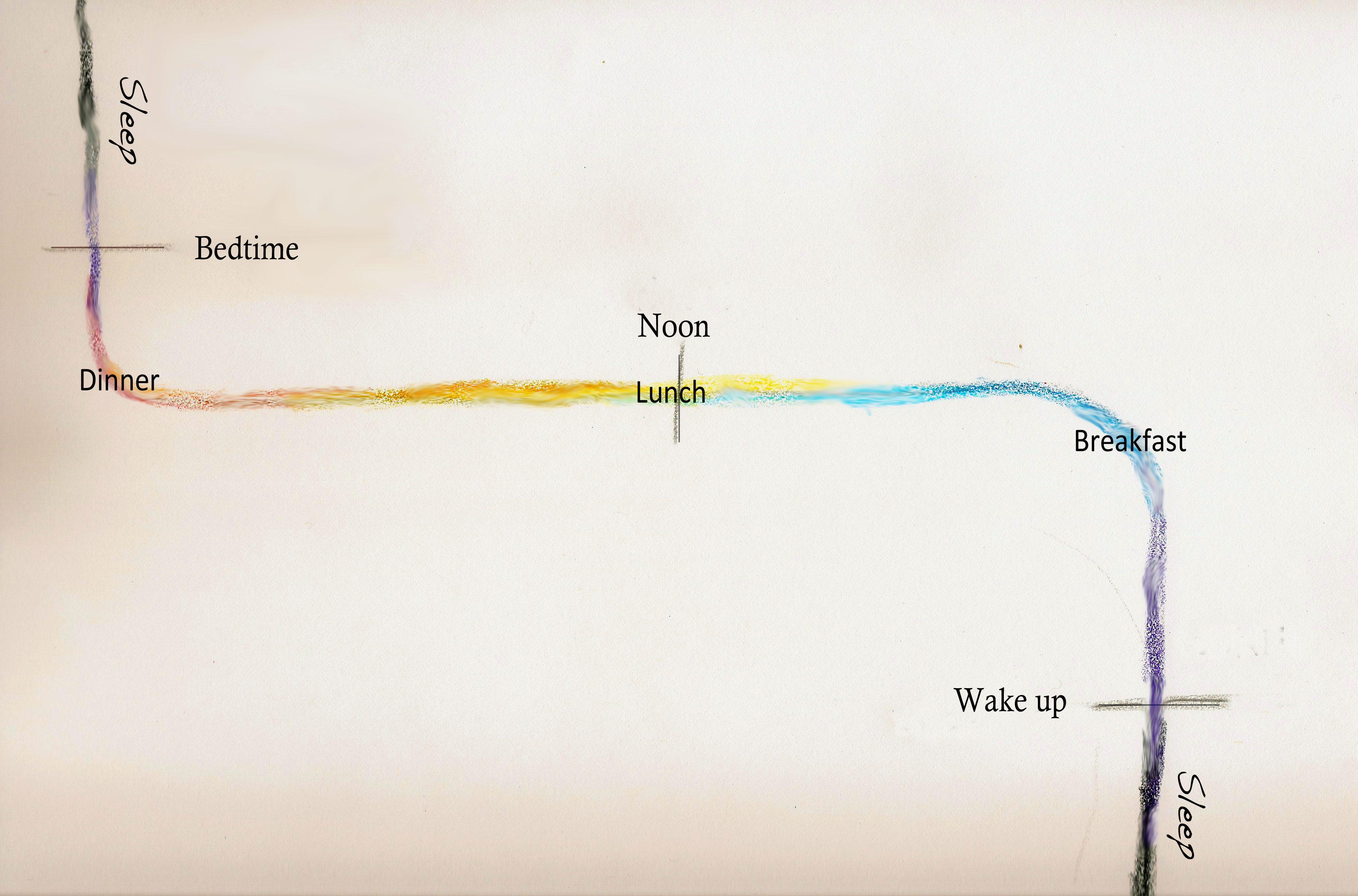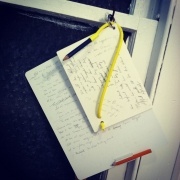I feel kind of like my brain gave me a present this week. On Tuesday, I learned that I’m a synesthete.
One of my friends shared this article, “Your name tastes like purple” on Facebook. “Uck,” I thought. “I really hope my name doesn’t taste like purple.” That should have been a sign.
Synesthesia, I learned, by reading the article, is a harmless perceptual condition in which one sense is directly related to another. Some people see colors when they hear sounds. Some people associate tastes with colors. The synesthete who penned the piece wrote about her ability to see letters in color and visualize the year. As I read, I thought “So? Who doesn’t do that? Everyone associates the letter A with red, right?” By the end of the article, I realized that everyone does not.
The most common form of synesthesia associates figures, like letters and numbers, with colors. The idea is that a person with this form of synesthesia sees the world as if it were an episode of Sesame Street. Letters and numbers are colored; always the same color for the same letter or number.
I do that to some extent. My A’s are red, my B’s are blue and my C’s are orange, but that’s only if I’m reciting the alphabet. For me, once the letters are combined into a word, the word takes on its own color and properties. “Vivid” is green, and smells like cut grass. “Whisper” is blue, except when it’s violet.
Some synesthetes associate personality traits with letters or colors. I do something similar, but in reverse. This is usually helpful, because I can remember people’s names by color. Jill is a bluish green. Eric is yellow-orange. Jennifer is purple and green. Kate is rose and orange. The only time I really make a mistake is if I confuse two names that look the same to me, like Adam and Aiden, or Fred and Joe.
The most memorable time this failed me happened in the second grade, when I realized that the principal of my elementary school, Sister Eileen, spelled her name with an A instead of an E. Aileen and Eileen sound exactly the same, but for me, they are radically different. Aileen is a red name. Eileen is a blue name. I panicked, because I had to relearn my principal’s personality. Ever since then, I’ve made a point of finding out the shape of people’s names – the spelling, the pronunciation, the color and the taste – early in my relationship with them.
Because sometimes I do taste certain words. “Fetch” tastes like parmesan cheese. “Bundle” is savory, like meat. “Purple” tastes like grape jelly, and I don’t like the word, because I hate grape jelly. “Fish” doesn’t actually taste like fish.
My visual relationship with words and letters has made me a proficient speller. I wish I saw numbers in color, because I can’t ever remember the order of numbers. Give me a figure with more than three digits, and I will inevitably mix up the numerals.
Despite that hurdle, my clearest synesthesia has to do with space, time and numbers. I see numbers as a line of whole, positive numbers, stretching across my fourth grade classroom. At 30, my numbers make a right and stretch out from there to infinity. When I view this number line, I am always standing at the number that represents my age. I think my number map might have impeded my ability to work with fractions and negative numbers in school, because there was no place on the map for a number like -0.057.
I see the year as a oblong pathway, with each month represented as a large paving stone, floating in the front yard of my childhood home. Holidays, my appointments and plans are written on the paving stones. The astrological signs float above the paving stones. Unlike some synesthetes’ calendars, which move, mine is fixed. I can remember when an event is simply by remembering where in my parents’ front yard I will be standing when it’s scheduled to happen. If I’m under the pine tree, it’s Christmas. If school’s out, I’m approaching the front porch. My weeks are shaped like L’s. My days are shaped like S’s. The hours of the days have colors. It sounds complex, but it’s not. The images have actually made me very good at scheduling.
I’ve had a blast this week, exploring the way I think about elementary concepts, like letters, numbers, colors, tastes or time. I took the synesthesia battery of tests over at Synesthete.org. I haven’t really given those concepts much thought since early childhood, and it’s interesting to consider the way they’ve developed in the last three decades. I never think about the way I think, so it’s been interesting to examine my perceptions or experiences in the light of synesthesia.
Because there were some things that seemed a little odd to me, like when I was a little girl playing with crayons: One purple crayon, which had more pink in it, made me feel thirsty. I get a dry mouth just thinking about that shade of purple. The other purple crayon, which was more blue, “quenched” that thirst.
And now I know why.



I also associate letters with colours. I thought that was normal, too. My brain is peculiar in that when I hear words, my mind converts them to print and then reads them before I can understand what’s being said. Needless to say, this slows me down, and I watch a lot of movies with subtitles to save time.
I’m REALLY curious now what colour my name (Ally) is.
I do that conversion-to-print thing too, but not as much as I used to. When I was a kid, it was like a typewriter was in my head. I would think something in print and then say it aloud. I still do it with names and difficult words, or when I’ve been typing a lot.
I’m so glad that you’re a synesthete too!
Oh, Ally is a red name, with a little blue in it.
i’ve decided you should publish this. just so you know.
You mean in a journal? I wonder if I can do that with blog posts.
This is really cool. I’m a sound-color, light-color, emotion-color, and personality-color synesthete, so I can both relate to this and be in awe of this. You seem to be very engaged with your synesthesia, which is good. A lot of times, it seems, synesthetes have to get to know themselves very well in order to figure out what everything means. I think it’s a good way to get in touch with yourself.
You’re absolutely right, exploring your synesthesia is a good way to understand yourself, because all your thoughts and associations are bound up in it. I’m 32 years old and over the years, as I’ve changed and as I’ve learned new things and made new associations, my synesthesia has changed as well. Right now I’m seeing if I can consciously change my synesthesia to help me with mathematics. It will be interesting to see if this works.
Thanks for commenting. I’m glad you found my blog.
I took the synesthesia questionnaire and got a score of .98 when 1.0 means you’re a synesthete. But I added in my comments that I experience the greatest sensation of synesthesia with number and emotions or mood. In math classes I had a lot of gut reactions to certain sets of numbers that don’t mesh well like 103, 59, or 47. But other combinations “felt” better like 63, 79 or 51.
Actually Rueben, a score UNDER 1.0 means you’re a synesthete. Did you take the letter/color test?
I did that number color. I don’t letter color associations with all letters for some reason.
How interesting…thanks for an insight into a whole new world of sensory perception!
I had the same reaction to that article title. To me, “purple” tastes like that grape cold medicine I used to get as a child.
Ah, Dimetapp. At least that stuff was better than Robitussin.
This is just fascinating.
It’s sort of cool to be able to articulate it now.